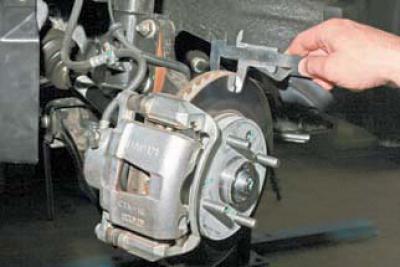Check the condition of the brake lines. The tubes must be securely fixed in the holders and must not have dents, mechanical damage, deep corrosion, or traces of brake fluid leakage.
Brake hoses must not be cracked, torn or frayed.
We check the condition of each hose by creating fluid pressure in the brake system. To do this, the assistant must press the brake pedal with force and hold it during the inspection. The appearance of blisters of rubber or leakage of brake fluid from the hose and its tips is not allowed. If damage is found, replace the hoses as a set.
We check the condition and degree of wear of the pads and discs of the brake mechanisms of the front and rear wheels.
To check, remove all the wheels one by one.

Through the window of the brake caliper of the front wheel, we estimate the thickness of the brake pads.
We replace the brake pads of the front wheels with a set if the thickness of any of the pads (friction lining with pad base) reached the maximum permissible value –– 7.0 mm (see Replacing the brake pads of the front wheels).
Turning the brake disc, inspect its working surfaces on both sides. There should be no cracks or deep grooves on the working surfaces of the disc.

We measure the thickness of the disk with a caliper, which should be at least 22.0 mm. At the same time, in different parts of the disk, it should not differ by more than 0.1 mm.
If, as a result of wear, a high shoulder has formed on the maximum diameter of the disc, which prevents accurate measurement, remove the shoulder with a file or otherwise, or measure the thickness of the disc with a micrometer.
We replace the brake disc with defects in working surfaces or extreme wear.

Through the window of the brake caliper of the rear wheel, we evaluate the thickness of the brake pads.
We replace the brake pads of the rear wheels with a set if the thickness of the friction lining (excluding the base of the block) any of the pads has reached the maximum permissible value –– 2.0 mm (see Replacing the brake pads of the rear wheels).
By analogy with the brake discs of the front wheels, we measure the thickness of the rear discs with a caliper, which should be at least 8.0 mm. At the same time, in different parts of the disks, it should not differ by more than 0.1 mm.
We replace the brake disc with defects in working surfaces or extreme wear.
Check the operation of the parking brake. The total travel of the parking brake lever should be 7-8 teeth (clicks) ratchet device sector. Adjust the parking brake if necessary (see Parking brake adjustment).
